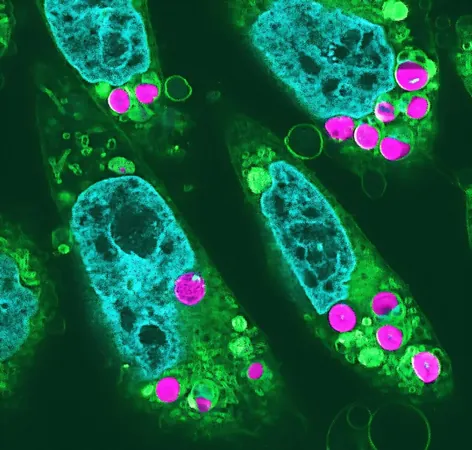
Revolutionary Breakthrough: Scientists Create Photosynthesizing Animal Cells!
2024-11-08
Author: Yan
In a groundbreaking achievement that blurs the lines of biology, researchers have successfully engineered animal cells with the remarkable ability to photosynthesize. This innovative advancement, spearheaded by Professor Sachihiro Matsunaga at the University of Tokyo, could not only revolutionize medical research but also pave the way for more sustainable lab-grown meat production.
What is Photosynthesis?
Photosynthesis is a natural process primarily observed in plants, algae, and some bacteria, where sunlight, water, and carbon dioxide are transformed into oxygen and glucose—a form of sugar that fuels growth. Plants rely on chlorophyll, the pigment responsible for their green color, to absorb sunlight and convert raw materials into energy. This critical process not only sustains plant life but also maintains the Earth's atmosphere, providing vital oxygen essential for many organisms, including humans.
Unveiling Photosynthesis in Animal Cells
"All living organisms on Earth depend on the process of photosynthesis, directly or indirectly," Professor Matsunaga explained. Traditional animal cells function in stark opposition: they consume oxygen, break down sugars, and release carbon dioxide. By integrating photosynthetic capabilities into these cells, the research team aims to reduce oxygen consumption and carbon dioxide emissions, essentially fashioning them into miniature oxygen creators.
A Challenge Nearly Half a Century in the Making
The ambition to develop photosynthesizing animal cells has intrigued scientists since the 1970s. "If we could manage even a fraction of the photosynthetic process in animal cells, the implications would be enormous—decreased oxygen consumption, less sugar intake, and a reduction in carbon emissions," said Matsunaga. However, the task was daunting, primarily due to animal cells' instinctual rejection of chloroplasts, the crucial components of photosynthesis found in plants.
Despite decades of unsuccessful attempts, Matsunaga's team undertook a meticulous, two-pronged approach to find chloroplasts that could thrive in the warmer environments typical of animal cells, usually cultured at around 37 degrees Celsius. They then allowed the cells to ingest these chloroplasts as food, successfully bypassing the biological rejection process.
Unexpected Results and Future Implications
To the team's astonishment, not only did the animal cells accept the chloroplasts, but they also exhibited an increased growth rate, indicating a newfound energy source within them. "This accomplishment comes as a surprise—achieving something thought impossible for half a century is nothing short of revolutionary," remarked Matsunaga.
The potential applications for these engineered cells are vast. In the realm of medical research, a significant hurdle in creating tissue for medical purposes or lab-grown meat is ensuring adequate oxygen supply to dense cell clusters. Matsunaga highlighted that embedding chloroplasts allows these clusters to generate their own oxygen when exposed to light, thus facilitating continued cell growth and division.
Looking to the future, Matsunaga envisions medical innovations where photosynthetic animal cells could assist in oxygen delivery for specific organs, like the heart. Imagine implanting a small LED device near the heart that could illuminate these cells, improving oxygen supply for individuals with heart disease.
Opening New Doors in Biological Engineering
While challenges remain—particularly in extending the lifespan of chloroplasts within animal cells—Matsunaga's research signals a noteworthy shift in biotechnology. This breakthrough opens avenues for pioneering techniques in food production, medical applications, and even climate change solutions by harnessing the transformative power of photosynthesis in new organisms.
This groundbreaking study has been published in the journal *Proceedings of the Japan Academy, Series B*, and stands as a testament to the limitless possibilities of scientific innovation—reshaping our understanding of biology and its applications in addressing some of humanity's most pressing challenges.
The scientific community eagerly anticipates further developments in this exciting field as Matsunaga and his team continue their pioneering work. Stay tuned for future updates on how this remarkable leap could change the landscape of medical research and food production forever!


 Brasil (PT)
Brasil (PT)
 Canada (EN)
Canada (EN)
 Chile (ES)
Chile (ES)
 España (ES)
España (ES)
 France (FR)
France (FR)
 Hong Kong (EN)
Hong Kong (EN)
 Italia (IT)
Italia (IT)
 日本 (JA)
日本 (JA)
 Magyarország (HU)
Magyarország (HU)
 Norge (NO)
Norge (NO)
 Polska (PL)
Polska (PL)
 Schweiz (DE)
Schweiz (DE)
 Singapore (EN)
Singapore (EN)
 Sverige (SV)
Sverige (SV)
 Suomi (FI)
Suomi (FI)
 Türkiye (TR)
Türkiye (TR)